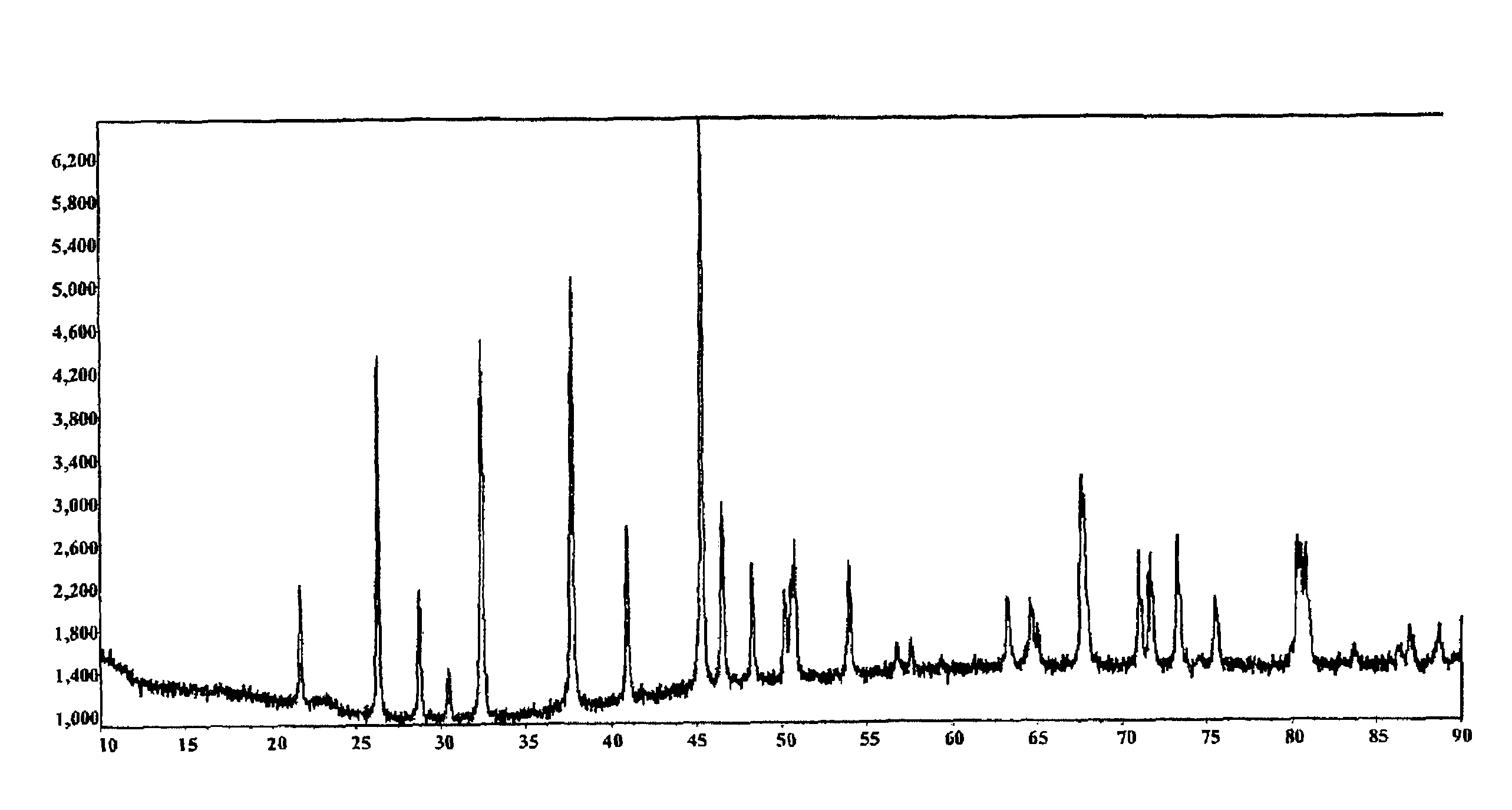Lithium iron phosphate of olivine crystal structure and lithium secondary battery using the same
a technology of olivine crystal structure and lithium secondary battery, which is applied in the direction of cell components, final product manufacturing, sustainable manufacturing/processing, etc., can solve the problems of low stability and high cost, limitations of mass-use as a power source for electric automobiles, and unsuitable for mass-production practical application
- Summary
- Abstract
- Description
- Claims
- Application Information
AI Technical Summary
Benefits of technology
Problems solved by technology
Method used
Image
Examples
example 2
[0098]21.5 g of LiOH—H2O, 27 g of aqueous ammonia (˜29 wt %), and 950.5 g of distilled water were mixed with one another and dissolved to prepare an aqueous solution A. In the same manner as above, 72.65 g of FeSO4-7H2O, 6.065 g of sucrose, 28.85 g of phosphoric acid (85 wt %), and 890.435 g of distilled water were mixed with one another and dissolved to prepare an aqueous solution B.
[0099]Supercritical water (430° C., 240 bar) was flowed at an elevated temperature and at an elevated pressure at 100 g / min into a continuous tubular reactor, and the aqueous solution A and the aqueous solution B were flowed at a flow rate of 15 g / min and brought in contact with the supercritical water for several seconds and mixed to induce reaction.
[0100]The resulting product was cooled and filtered at the end of the tubular reactor to obtain a slurry containing an intermediate. A controlled concentration of water was added to the slurry to obtain a slurry having a solid content of 20 wt %, and 7 wt %...
example 3
[0101]40.9 g of LiOH—H2O, 32.4 g of aqueous ammonia (˜29 wt %), and 934.7 g of distilled water were mixed with one another and dissolved to prepare an aqueous solution A. In the same manner as above, 140.3 g of FeSO4-7H2O, 13.13 g of sucrose, 57.7 g of phosphoric acid (85 wt %), 3.1 g of sulfur and 767 g of distilled water were mixed with one another and dissolved to prepare an aqueous solution B. Supercritical water (450° C., 250 bar) was flowed at an elevated temperature and at an elevated pressure at 100 g / min into a continuous tubular reactor, and the aqueous solution A and the aqueous solution B were flowed at a flow rate of 15 g / m in and brought in contact with the supercritical water for several seconds and mixed to induce reaction. At this time, the aqueous solution A first contacted the aqueous solution B to produce a slurry and was then reacted with the supercritical water. The aqueous solution A was reacted with supercritical water as soon as possible after production of ...
example 4
[0105]34.8 g of LiOH—H2O, 37.1 g of aqueous ammonia (˜29 wt %), and 904.7 g of distilled water were mixed with one another and dissolved to prepare an aqueous solution A. In the same manner as above, 104.2 g of FeSO4-7H2O, 14.13 g of sucrose, 57.7 g of phosphoric acid (85 wt %), 15.3 g of NiSO4-7H2O and 795.7 g of distilled water were mixed with one another and dissolved to prepare an aqueous solution B. Supercritical water (455° C., 240 bar) was flowed at an elevated temperature and at an elevated pressure at 100 g / min into a continuous tubular reactor, and the aqueous solution A and the aqueous solution B were flowed at a flow rate of 15 g / min and brought in contact with the supercritical water for several seconds and mixed to induce reaction. At this time, the aqueous solution A first contacted the aqueous solution B to produce a slurry and was then reacted with the supercritical water. The aqueous solution A was reacted with supercritical water as soon as possible after producti...
PUM
| Property | Measurement | Unit |
|---|---|---|
| thickness | aaaaa | aaaaa |
| volume density | aaaaa | aaaaa |
| thickness | aaaaa | aaaaa |
Abstract
Description
Claims
Application Information
 Login to View More
Login to View More - R&D
- Intellectual Property
- Life Sciences
- Materials
- Tech Scout
- Unparalleled Data Quality
- Higher Quality Content
- 60% Fewer Hallucinations
Browse by: Latest US Patents, China's latest patents, Technical Efficacy Thesaurus, Application Domain, Technology Topic, Popular Technical Reports.
© 2025 PatSnap. All rights reserved.Legal|Privacy policy|Modern Slavery Act Transparency Statement|Sitemap|About US| Contact US: help@patsnap.com


